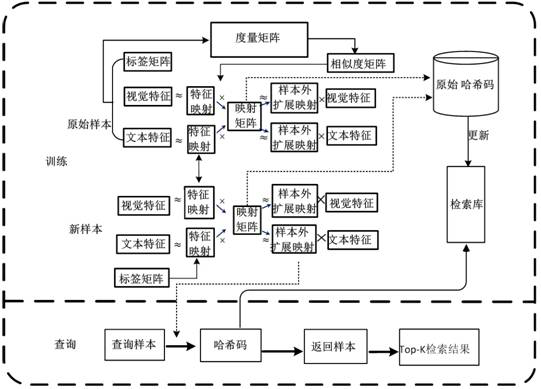Online cross-modal retrieval method and system based on similarity re-learning
A re-learning, cross-modal technology, applied in the field of cross-modal retrieval, can solve the problems of small number of paired samples, difficult to maintain, and difficult to optimize the loss function, so as to improve retrieval accuracy and avoid cumulative quantization errors Effect
- Summary
- Abstract
- Description
- Claims
- Application Information
AI Technical Summary
Problems solved by technology
Method used
Image
Examples
Embodiment 1
[0033] In one or more embodiments, an online cross-modal retrieval method based on similarity re-learning is disclosed. First, the training samples are uniformly grouped to generate flow data, and then multi-metric matrix learning is performed. After that, the combined The matrix factorization approach learns the common mapping of old and new data as well as the common representation of different modalities. At the same time, in the learning process, two kinds of supervision information are introduced: 1) through the newly learned multi-metric matrix to measure the similarity relationship between old and new samples in multiple modalities; 2) to mine the category information between new samples through label embedding . Finally, a strategy is devised to efficiently update the hash codes of the original samples. During the retrieval process, the hash code is generated for the query sample through the out-of-sample extended mapping, and compared with the hash code in the update...
Embodiment 2
[0089] In one or more embodiments, an online cross-modal retrieval system based on similarity re-learning is disclosed. The system adopts the online cross-modal retrieval method based on similarity re-learning described in Embodiment 1 to realize Online cross-modal search.
Embodiment 3
[0091] In one or more embodiments, a terminal device is disclosed, including a server, the server includes a memory, a processor, and a computer program stored on the memory and operable on the processor, and the processor executes the The program realizes the online cross-modal retrieval method based on similarity re-learning in the first embodiment. For the sake of brevity, details are not repeated here.
[0092] It should be understood that in this embodiment, the processor can be a central processing unit CPU, and the processor can also be other general-purpose processors, digital signal processors DSP, application specific integrated circuits ASIC, off-the-shelf programmable gate array FPGA or other programmable logic devices , discrete gate or transistor logic devices, discrete hardware components, etc. A general-purpose processor may be a microprocessor, or the processor may be any conventional processor, or the like.
[0093] The memory may include read-only memory a...
PUM
 Login to View More
Login to View More Abstract
Description
Claims
Application Information
 Login to View More
Login to View More - R&D
- Intellectual Property
- Life Sciences
- Materials
- Tech Scout
- Unparalleled Data Quality
- Higher Quality Content
- 60% Fewer Hallucinations
Browse by: Latest US Patents, China's latest patents, Technical Efficacy Thesaurus, Application Domain, Technology Topic, Popular Technical Reports.
© 2025 PatSnap. All rights reserved.Legal|Privacy policy|Modern Slavery Act Transparency Statement|Sitemap|About US| Contact US: help@patsnap.com



